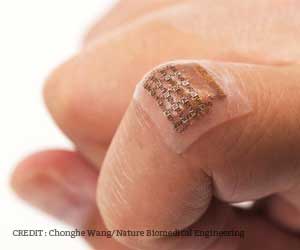These waves reflect out to produce high-resolution images of a patient’s heart, lungs, and other deep organs. Currently, ultrasound imaging requires bulky and specialized equipment available only in hospitals and doctor’s offices [2]. But this new design can change this scenario.
Researchers applied the stickers to volunteers and showed the devices produced live, high-resolution images of major blood vessels and deeper organs such as the heart, lungs, and stomach.
Advertisement
The stickers maintained a strong adhesion and captured changes in underlying organs as volunteers performed various activities, including sitting, standing, jogging, and biking.
The current design requires connecting the stickers to instruments that translate the reflected sound waves into images. The researchers point out that even in their current form, the stickers could have immediate applications.
For instance, the devices could be applied to patients in the hospital, similar to heart-monitoring EKG stickers, and could continuously image internal organs without requiring a technician to hold a probe in place for long periods.
If the devices can be made to operate wirelessly, the ultrasound stickers could be made into wearable imaging products that patients could take home from a doctor’s office or even buy at a pharmacy.
“We envision a few patches adhered to different locations on the body, and the patches would communicate with your cellphone, where AI algorithms would analyze the images on demand,” says the study’s senior author, Xuanhe Zhao, professor of mechanical engineering and civil and environmental engineering at MIT.
Beginning of New Era of Wearable Ultrasound Imaging
To image with ultrasound, a technician first applies a liquid gel to a patient’s skin, which acts to transmit ultrasound waves. A probe, or transducer, is then pressed against the gel, sending sound waves into the body that echo off internal structures and back to the probe, where the echoed signals are translated into visual images.
For patients who require long periods of imaging, some hospitals offer probes affixed to robotic arms that can hold a transducer in place without tiring, but the liquid ultrasound gel flows away and dries out over time, interrupting long-term imaging.
In recent years, researchers have explored designs for stretchable ultrasound probes that would provide portable, low-profile imaging of internal organs. These designs gave a flexible array of tiny ultrasound transducers, the idea being that such a device would stretch and conform to a patient’s body.
But these experimental designs have produced low-resolution images, in part due to their stretch: In moving with the body, transducers shift location relative to each other, distorting the resulting image.
Wearable ultrasound imaging tools would have huge potential in the future of clinical diagnosis. However, the resolution and imaging duration of existing ultrasound patches is relatively low, and they cannot image deep organs.
The MIT team’s new ultrasound sticker produces higher resolution images over a longer duration by pairing a stretchy adhesive layer with a rigid array of transducers. This combination enables the device to conform to the skin while maintaining the relative location of transducers to generate clearer and more precise images.
How Effective is Adhesive Ultrasound Imaging Device?
Researchers ran the ultrasound sticker through a battery of tests with healthy volunteers, who wore the stickers on various parts of their bodies, including the neck, chest, abdomen, and arms.
From the stickers’ images, the team was able to observe the changing diameter of major blood vessels when seated versus standing. The stickers also captured details of deeper organs, such as how the heart changes shape as it exerts during exercise[3].
They were also able to watch the stomach distend, then shrink back as volunteers drank then later passed juice out of their system. And as some volunteers lifted weights, the team could detect bright patterns in underlying muscles, signaling temporary microdamage.
The team is working to make the stickers function wirelessly. They are also developing software algorithms based on artificial intelligence that can better interpret and diagnose the stickers’ images.
Then, ultrasound stickers could be packaged and purchased by patients and consumers and used not only to monitor various internal organs, but also the progression of tumors, as well as the development of fetuses in the womb.
References :
Source: Medindia



